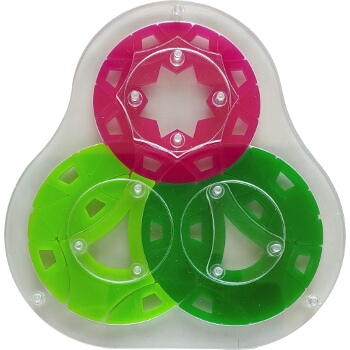
Above:Solved
Click a thumbnail to see its larger version and description.
Three intersecting circles with one 8-fold rotation and two non-infinite fivefold rotation.
Taygeta (19 Tauri) is a triple star system in the constellation of Taurus and a member of the Pleiades open star cluster.
Based on parallax measurements obtained during the Hipparcos mission, Taygeta is approximately 440 light-years from the Sun.
19 Tauri A presents as a blue-white B-type subgiant with an apparent magnitude of +4.30. It is a spectroscopic binary, whose component stars have magnitudes of +4.6 and +6.1. They are separated by 0.012 arcseconds and complete one orbit every 1313 days.
The 8th magnitude visual companion, 19 Tauri B, is 69 arcseconds away. It is thought to be a yellow star somewhat more massive and larger than the Sun, and further away than the Pleiades cluster.
In Classical Greek mythology, Taygete was a nymph, one of the Pleiades and a companion of Artemis, in her archaic role as potnia theron, "Mistress of the animals", with its likely roots in prehistory. Mount Taygetos in Laconia, dedicated to the goddess, was her haunt.
As he mastered each of the local nymphs one by one, Olympic Zeus pursued Taygete, who invoked her protectress Artemis. The goddess turned Taygete into a doe with golden horns, any distinction between the Titaness in her human form and in her doe form is blurred: the nymph who hunted the doe in the company of Artemis is the doe herself. As Pindar conceived the myth-element in his third Olympian Ode, "the doe with the golden horns, which once Taygete had inscribed as a sacred dedication to Artemis Orthosia", ("right-minded" Artemis) was the very Ceryneian Hind that Heracles later pursued. For the poet, the transformation was incomplete, and the doe-form had become an offering. Pindar, who was a very knowledgeable mythographer, hints that the mythic doe, even when slain and offered to Artemis, also continues to exist, to be hunted once again (although not killed) by Heracles at a later time. Karl Kerenyi points out (The Heroes of the Greeks) "It is not easy to differentiate between the divine beast, the heroine and the goddess".
The puzzle consists of three intersecting circles. One allows rotations in steps of 45�. The other allow five steps of rotation. The two elongated pieces in the lower two circles enforces that these two circles can be turned only when the other is in one of two states.
Size: 148 x 156 mm
Weight: 141 grams
Links

Contributors
No one has contributed to this page yet!
Collections
This puzzle can be found in collections of these members:
Found a mistake or something missing?
Edit it yourself or
contact the moderator.



